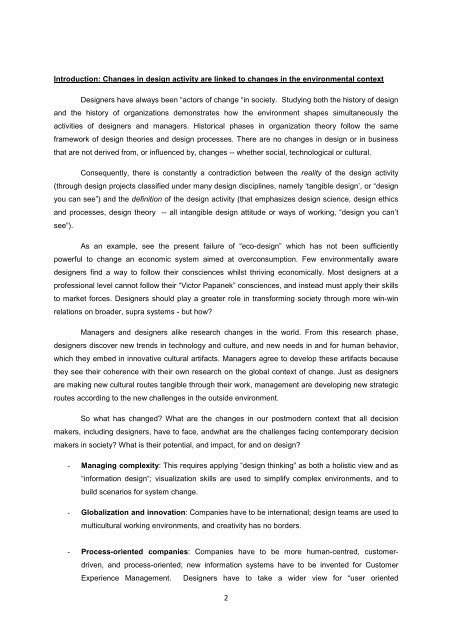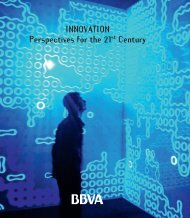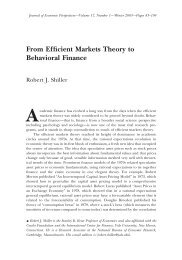Design Management as core competency
Design Management as core competency
Design Management as core competency
Create successful ePaper yourself
Turn your PDF publications into a flip-book with our unique Google optimized e-Paper software.
Introduction: Changes in design activity are linked to changes in the environmental context<br />
<strong>Design</strong>ers have always been “actors of change “in society. Studying both the history of design<br />
and the history of organizations demonstrates how the environment shapes simultaneously the<br />
activities of designers and managers. Historical ph<strong>as</strong>es in organization theory follow the same<br />
framework of design theories and design processes. There are no changes in design or in business<br />
that are not derived from, or influenced by, changes -- whether social, technological or cultural.<br />
Consequently, there is constantly a contradiction between the reality of the design activity<br />
(through design projects cl<strong>as</strong>sified under many design disciplines, namely ‘tangible design’, or “design<br />
you can see”) and the definition of the design activity (that emph<strong>as</strong>izes design science, design ethics<br />
and processes, design theory -- all intangible design attitude or ways of working, “design you can’t<br />
see”).<br />
As an example, see the present failure of “eco-design” which h<strong>as</strong> not been sufficiently<br />
powerful to change an economic system aimed at overconsumption. Few environmentally aware<br />
designers find a way to follow their consciences whilst thriving economically. Most designers at a<br />
professional level cannot follow their “Victor Papanek” consciences, and instead must apply their skills<br />
to market forces. <strong>Design</strong>ers should play a greater role in transforming society through more win-win<br />
relations on broader, supra systems - but how<br />
Managers and designers alike research changes in the world. From this research ph<strong>as</strong>e,<br />
designers discover new trends in technology and culture, and new needs in and for human behavior,<br />
which they embed in innovative cultural artifacts. Managers agree to develop these artifacts because<br />
they see their coherence with their own research on the global context of change. Just <strong>as</strong> designers<br />
are making new cultural routes tangible through their work, management are developing new strategic<br />
routes according to the new challenges in the outside environment.<br />
So what h<strong>as</strong> changed What are the changes in our postmodern context that all decision<br />
makers, including designers, have to face, andwhat are the challenges facing contemporary decision<br />
makers in society What is their potential, and impact, for and on design<br />
- Managing complexity: This requires applying “design thinking” <strong>as</strong> both a holistic view and <strong>as</strong><br />
“information design“; visualization skills are used to simplify complex environments, and to<br />
build scenarios for system change.<br />
- Globalization and innovation: Companies have to be international; design teams are used to<br />
multicultural working environments, and creativity h<strong>as</strong> no borders.<br />
- Process-oriented companies: Companies have to be more human-centred, customerdriven,<br />
and process-oriented; new information systems have to be invented for Customer<br />
Experience <strong>Management</strong>. <strong>Design</strong>ers have to take a wider view for “user oriented<br />
2
















